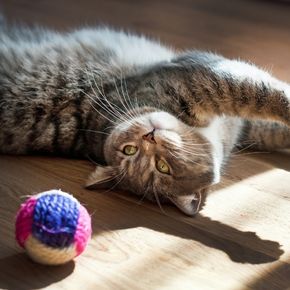
You’ve seen the memes with cats stuck in Christmas trees, but what else can go wrong during the festive season when you have cats? Head Vet Victoria Seale, shares common causes of Christmas cat injuries and advises how to avoid them.
Given how curious cats are, it makes sense to keep our number in your phone just in case your cat gets into any bother.
Call 020 7229 2040 for cat advice
Six common cat concerns at Christmas in London:
Road traffic accidents
With all the noise and commotion that comes with Christmas, including extra guests at your home, cats often roam outdoors to escape the mayhem. As it gets darker earlier during winter, your cat is more at risk of being hit by a car. Victoria recommends fitting your cat with a reflective collar and providing ‘safe spaces’ indoors for your cat to take solace in when it gets too much.
Consuming harmful food & drink
Christmas can be a fun time of year for cats, with tasty morsels of food and leftover drinks all over the place to try. Some items such as pigs in blankets could give your cat an upset stomach, whereas toxic treats like chocolate or mince pies (containing dried fruit) could cause them severe harm. It’s wise to keep food, alcohol, and paracetamol (for the Boxing Day hangover) behind a closed cupboard, pantry, or fridge door and away from curious cats.
Plant poisoning
Poinsettias, holly, and mistletoe are festive favourites for many households. Unfortunately for cats, they can cause a variety of health problems ranging from nausea and vomiting, to collapse and seizures. Victoria recommends keeping harmful Christmas plants out of reach, or not keeping them at all.
ANTIFREEZE ALERT
– This substance is highly toxic to cats but tastes sweet (so we hear). Clean up any spills and keep the container somewhere your cat can’t get to it – remember cats can climb!
Christmas tree injuries
Saying cats and Christmas trees don’t mix well is an understatement in some households. Cats love to play with delicate baubles and wires, climb the tree, eat the needles, and rub themselves against the branches – all of which can end badly. Victoria has this advice for cat owners:
- Consider choosing an artificial tree – real fir trees produce toxic oils that can harm cats when eaten or absorbed through the skin and eating pine needles can cause a lot of pain.
- Smaller Christmas trees should cause less damage to your cat if they fall over – secure your tree to a wall or ceiling or use a heavy base to steady it.
- Choose shatterproof or soft hanging tree decorations and nothing edible if you have pets.
- Keep wires contained so they don’t look like string to play with to your cat.
- Decorate your tree without your cat in the room and avoid leaving your cat alone with it.
Burns & scalds
Cats can easily get burned or scalded accidentally at Christmas time, with knocked over candles and cooking pans being the common causes. Avoid injuries by keeping candles out of reach, or your cat out of the room, especially the kitchen when you’re cooking.
We hope you found Victoria’s advice useful. As always, if you have any concerns about your cat, get in touch with us here at Bayswater Veterinary Clinic in Bayswater.

The natural behaviour of cats can be hilarious, mischievous, loving and annoying in equal measure, as any owner will testify. You only have to look at YouTube or Instagram to see how they amuse and frustrate with their antics.
Whilst we sit back and enjoy the entertainment, every cat lover should ensure their pet stays in peak condition with a regular check-up. If your cat has not seen a vet for a while then why not contact us on 020 7229 2040 to book an appointment now?
In the meantime, we’d love to see the fun your cat gets up to. So, we’re inviting you to check-out our list of Ten Truths every cat owner will know below, and share a pic of them living one of these truths on our Facebook page.
Post your ‘Cat Truth’ picture to Facebook
- You can have a cat, or houseplants. Not both.
- You just have to accept that your sofa is now a scratching post. That’s never going to change.
- The one day you walk downstairs barefoot will be the day the cat has left a furball for you to tread on.
- If the cat falls asleep on you, you can’t move until it wakes. However long that takes.
- When you’re sound asleep, your feet are fair game.
- Cats will always prefer the box to the toy.
- They won’t often have a mad five minutes, but when they do it’ll be loud. And at 3am when the whole house is asleep!
- You no longer have your own food, just what the cat lets you eat.
- When they need to vomit, they’ll do it on your most prized possession.
- It doesn’t matter how naughty or destructive they’ve been, you’ll always forgive them – and never stop loving them.
Obviously, the above also applies to kittens, only with extra helpings of cuteness.
If you have a new addition to the household, you can make an appointment to register it with Bayswater Veterinary Clinic on 020 7229 2040. Let’s get a check-up booked in to make sure those endearing moments don’t get interrupted by an unexpected health issue.
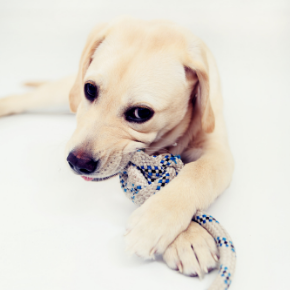
A lot of families in the Bayswater area got themselves a puppy over the recent lockdown. Typically, in the run-up to Christmas, even more will join that happy group. However, shortly after that cute furball has arrived you’ll get your first nip from those pin-sharp teeth and next thing you know … the cute furball has destroyed your sofa and your slippers.
Your pup has just entered what we call the ‘Chewing Phase’ and shortly you’ll want the answers to a few common questions. Our head vet Adam has anticipated your puppy chewing questions and answers the common ones below. Let us know how our tips work out for you and share your own puppy chewing hints & hacks on our Facebook page.
WHY DOES MY PUPPY CHEW?
There are four main reasons your puppy will chew. Understand the cause of their chewing and you can quickly plan ways to help them (and you) out.
- They are teething. Just like human babies, when your puppy has a new tooth coming in their gums will feel sore, so they chew to ease the pain.
- Puppies chew, nip and ‘mouth’ to strengthen their jaw. This is a basic dog behaviour that lasts through to adulthood to keep their jaw muscle strong.
- They chew as they learn acceptable social behaviours. They learn from relationships between their actions and the reactions of other dogs (and of course you).
- They chew because they are bored.
HOW LONG DOES THE PUPPY CHEWING PHASE LAST?
Longer than you think! Actually, until they are 1 to 2 years old (depending on the breed and personality of your dog). At around 2-3 weeks your pup’s ‘puppy teeth’ emerge. At around 4 months old, adult teeth begin to come through. Then, from 7-12 months, adolescent chewing kicks in as the new teeth settle down and your pub begins to explore the world.
What you can do about puppy chewing
Now you know the causes, here are a few hints and tips to help you manage puppy chewing at home:
1. Puppy proof your home
Prepare for success by putting the chewable things you can out of reach; Slippers, electrical flexes and children’s toys need to be moved if they are to be saved
2. Train them at home
If they chew something they shouldn’t, immediately replace it with something they can. When they have their own object in their mouth, give lots of positive attention. If they nip or mouth you or your clothing, tell them ‘No’, then disengage. A minute later, put their toy in their mouth and start engaging and playing again
3. Learn how to confine them
When you need to go out or be away from your puppy, putting them in a crate or a confined area is important for their safety and development. It also gets them used to being in an area where they can get some downtime.
4. Give them more stimulation
Confinement is not a substitute for your lack of attention. Positive stimulation a socialisation is one of the most important factors in your new pup’s development. When your puppy starts destructive chewing, they’re probably just attention-seeking so lengthen the daily walk (or go out multiple times) and introduce more stimulating activities.
5. Get a few chew toys
Invest in high-quality dog specific chew toys that are built to last. No sticks please and no toys they can destroy and eat (you may need to persevere here). We often have good ones in the surgery, so speak to Kate, or one of the other nurses for their advice on the best ones for your pup.
6. Consider puppy classes
These will teach you and your puppy how to give and react to basic commands. Classes will teach you how to handle and socialise your dog and better still, these sessions will tire them out. One thing you’ll come to learn is that a tired puppy is much less likely to chew your belongings.
Puppy chewing will end
Before you know it, the chewing phase is over and all you’ve got to remember it is half a dozen destroyed slippers. Remember, manage their environment, teach them what’s acceptable and provide lots of the right stimulation. After all, that’s the joy of having a puppy! Right?
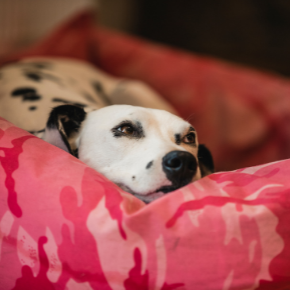
If you are thinking about breeding your female dog for the first time, or there has been an ‘unexpected incident’, you’ll need to know some facts about dog pregnancy.
Bayswater Vets’ head vet Victoria Seale, is here to help. Read Victoria’s answers to frequently asked questions on the subject, from pet owners in London.
Book a dog pregnancy consultation
How did my dog get pregnant? – Besides the obvious ‘birds & bees’ explanation, it’s helpful to know that female dogs can’t get pregnant all the time. An unneutered female’s ‘heat’ season typically starts between 6 – 36 months of age, lasting 3 weeks at a time, about twice a year.
Female dogs ‘in heat’ can be impregnated by an ‘in-tact’ male dog when you least expect it i.e., out on a walk, visiting someone’s home, doggy day-care, and even in your home or garden. Unneutered male dogs are known to stop at nothing to reach a female.
How long are dogs pregnant for? – A dog pregnancy can vary between 56 – 70 days. Typically, puppies should arrive about 63 days (just over 2 months) after conception.
Are there any tell-tale dog pregnancy symptoms? – Like humans, some dogs can suffer from ‘morning sickness’ and will vomit in the early stages of pregnancy. Other early dog pregnancy symptoms can be subtle including changes to appetite, slightly enlarged nipples, clear vaginal discharge, increased tiredness, and more affectionate behaviour.
During the latter stages, expect weight gain, increased appetite, and behaviour changes. Her teats may become darker, stand out more, and produce a semi-clear discharge. An enlarged abdomen with visible puppy movement is a great sign that puppies are on the way.
Can I buy a dog home pregnancy test?
There is no shop-sold home dog pregnancy test available, like those you can buy for humans. One of our experienced vets may use a hormone test, ultrasound, or a physical examination of the abdomen, to confirm whether your dog is pregnant.
How can I prepare for my dog giving birth?
- Create a nest: Make a quiet, relaxing, and private space for your dog to give birth and nurse puppies in. Line a large cardboard box or whelping box with puppy pads and clean bedding. Add her own clean toys/bedding to get her used to it.
- Prep in advance: Gather clean towels, nail scissors, and small blankets. Microwavable bean bags can provide warmth if you need to move puppies away from mum for any reason.
- Talk to our experienced vets: Know the signs of labour and distress to look out for. You should be as hands off as possible, but always there to support and intervene if needed.
- Be ready for an emergency: Dogs often give birth at night, and sometimes an emergency caesarean is required. Victoria recommends a) popping our emergency contact information in your phone, b) having transport available, and c) packing anything you’ll need to take with you (wallet, keys, blankets, puppy carrier etc.), in advance.
How long is a dog in labour?
Depending on the number of puppies, labour normally lasts between 3 – 12 hours. When you book your dog pregnancy appointment at our Bayswater practice, ask us about the three stages of dog labour.
Think your dog could be pregnant? Book a vet consultation so we can run some tests and help you understand what happens next.

Your accommodation is booked and you’re excitedly counting down the weeks until your summer holiday. Your guinea pig might not be quite as thrilled, however, about your upcoming trip…
Guinea pigs can become easily stressed by sudden changes to their environment or routine, which can present as irritability, aggression, depression, reduced activity, and self-mutilation. Our Alexander Street nurses have come up with a list of things guinea pig owners should consider when planning time away.
Share your pet’s holiday prep on Facebook
How to prevent Guinea Pig Holiday Blues
You can minimise stress by asking someone you trust to provide daily care for your guinea pig at your home while you’re away. Live-in care would be ideal, or at least two daily visits.
It’s helpful to think about whether your chosen pet sitter knows how to take care of guinea pigs if they’ve not done so before. Our list below covers what care guinea pigs need and will help you create a personalised ‘how to guide’ for their holiday carer.
10 things guinea pigs need while you’re on holiday
- Routine – Consistency can reduce potential stress so write down your guinea pig’s routine, including feeding times, exercise, and grooming. Any changes should be introduced gradually.
- A meal plan – Stock up on your guinea pig’s food and create a meal plan for the time you’re away, including treats. Ask your pet sitter to stick to the plan to keep your pet happy & healthy.
- Fresh water – Your pet’s water bowl/bottle will need changing daily so they always have access to fresh water. Bottles should also be checked daily for blockages.
- Summer care – If it’s going to be hot in London while you’re away, move the hutch somewhere cool, safe and well ventilated, away from direct sunlight. Guinea pigs need some carefully monitored time in natural sunlight (or under a UV lamp) to help them get the vitamin D they need. An outdoor playpen can be useful.
- Grooming – We can check if your pet’s teeth need filing and nails need clipping before you go, just ask our team. Long-haired guinea pigs especially need daily grooming to remove tangles, mats, and bedding from their hair – show your pet sitter how.
- Daily/weekly cleaning – To avoid harmful health conditions, your guinea pig and their hutch should be kept clean, dry, and free of excess dust. Replace soiled bedding daily. Gently clean & dry your pet’s bottom if needed with pet shampoo. Hutches should have a thorough clean weekly.
- Boredom busters – Boredom can affect your guinea pig’s health. Keep them occupied with enriching toys and challenges that enable them to mimic wild behaviours. Try hanging treat balls, tubes/tunnels, foraging trays, and digging boxes. Remember though, they’re not great climbers!
- Handle with care – Falls are a risk for small furry pets, particularly when being handled by someone new. Show your pet sitter how, keeping your pet close to the chest or lap for safety.
- Keep unneutered girls and boys apart – Ensure your sitter knows to keep ‘intact’ males and females apart unless you want to come home to expectant parents!
- Know the signs – Common guinea pig illnesses needing urgent veterinary care include:
- Flystrike – look for wet fur patches (incontinence), flies & maggots particularly on the rear.
- Not eating or drinking for 6+ hours – look for appetite/thirst loss, less stools/urination.
- Bacterial pneumonia – Look for respiratory distress, eye/nose discharge, sneezing, weight loss, depression.
We hope our list above helps your guinea pig have an enjoyable time when you go on holiday. Just in case there are any issues, see our contact and emergency pet care information here.
You could help other guinea pig owners by sharing your pet’s holiday preparation plans on our Facebook page.
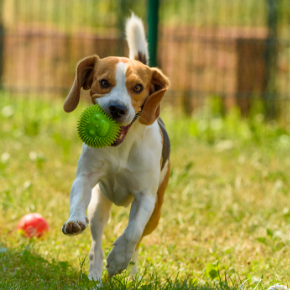
It’ll come as no surprise to hear that dogs are the UK’s most popular pets, estimated at around 9 million, closely followed by cats at an estimated 8 million.
But given that there are some 51 million pets in the UK, according to the RSPCA and figures estimated by the Pet Food Manufacturers’ Association, there are obviously a lot of other types of animals around. The team at Bayswater Veterinary Clinic thought it would be fun to find out the range of pets in London.
We’d love to see pictures of your pet, so please get in touch and post your pet photos.
April is National Pet Month when lots of organisations join forces to promote responsible pet ownership and increase awareness of the benefits of living with animals and the valuable role they can play in helping people through therapy or assistance.
So what better time to share your pet experiences? Share your funny stories and heartwarming tales involving your pets and upload a photo while you’re at it.
It’s easy for people to immediately think dogs and cats when they hear the word ‘pet’, but many pet owners share their homes with more unusual creatures, from insects and ferrets to snakes and horses, so there is a wide variety of interaction between humans and animals and we’re sure your stories will make for fascinating reading.
We can’t wait to hear your anecdotes, so why not go to our social media page and start sharing?
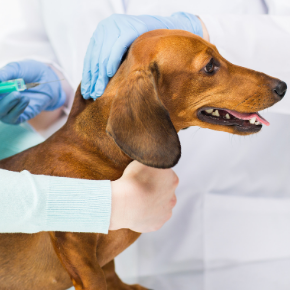
As temperatures tiptoe towards double figures again, we’re all feeling a little ‘spring in our step’, including our pets. Now that your dog will undoubtedly be spending more time outdoors, our head nurse Kate Locke has come up with a handy spring checklist:
5 things you can do to get your dog ready for spring:
1. Check your dog’s vaccinations are up to date – Being outdoors more and mixing with other dogs at the park increases your dog’s chances of contracting kennel cough and other contagious diseases if their vaccinations aren’t up to date. Check when they last had their jabs and book an appointment if their 12 months are up. Adult dog vaccines typically give a tapered 3-month immunity, but waiting longer can sometimes mean starting their vaccination course again from the beginning.
Contact us to check your dog’s vaccinations are up to date.
2. Apply monthly flea & worm treatments – Fleas and worms can be problematic all year round but tend to be more prevalent during spring and summer. Fleas spread quickly and can carry diseases, and worms can harm your pet inside and out. Contracting lungworm can actually be fatal. Protect your dog against these springtime hazards by keeping up to date with monthly flea & worm treatments.
3. Think ticks – Ticks are found mostly in long grass and where deer or sheep roam, and are most active in the spring and summer. Some flea products protect against ticks as well, or you can buy tick-specific products. You can always talk to Kate about whether your dog would benefit from tick protection and how to remove a tick safely (never pull a tick straight out). Ticks can spread Lyme disease and Babesiosis so it’s important to know if the area you’re walking in is high-risk – you can check this online here.
4. Be allergy aware – Seasonal allergies such as hay fever can make some dogs very unwell. If you spot the tell-tale signs it would be worth bringing your dog in to get checked. Canine hay fever symptoms include frequent, repeated sneezing; irritated & itchy eyes (could also be red or runny); a runny nose; increase in itching or biting at the skin (showing skin irritation); scratching excessively resulting in bald or sore patches of skin; rashes on the paws or face.
5. Take note of toxic plants – Finally, you can complete your spring checklist by making sure you’re aware of which plants are toxic to dogs now that they’ll be out and about more. These include Azalea, Bittersweet, Crocus, Day Lily, Ferns, Lily of the Valley, Morning Glory, Tiger Lily, and Tulip.
If you need to check your dog’s vaccinations or want any advice on spring health concerns, get in touch with our team.

Christmas for our feline friends should definitely include some cat toys (who doesn’t like a toy for Christmas?!). But for the family moggy there are plenty of other things you might get them too. We have a selection of Christmas gifts for your pets in our reception but, in addition to these, our head nurse Kate called a short but inspirational meeting and here’s a longer list of inspiration that we came up with.
Ask about gifts we have in stock. Contact Us.
Our Cat Toy & Christmas Gifts Ideas
- Cat Toys – Cats love anything with catnip, especially if it’s small and moves. With our long-stay cat patients in Bayswater we often entertain them with small squeaky mice stuffed with catnip.
- Food – Whatever you choose as a treat, do buy good quality, and don’t change your cat’s diet too quickly.
- Bedding – There are some great new bedding ideas around, so why not treat your cat to a comfier Christmas?
- Climbing frame – Cats just love to climb, so why not keep the Christmas tree safe and treat yours to its own specially designed climbing frame?
- Water fountain – These are great for encouraging cats to take more water on board, especially if they eat dry food or have bladder or kidney disease.
- Grooming tools – All cats like and need to keep their coat in tip-top condition, so what better gift than a new grooming brush? Kate and the team are the best people to advise you on brushes and combs. Call them for advice.
- Microchip or GPS collar – There are more ways than ever to keep tabs on our pets these days. Just google ‘GPS Cat collars’ and take your pick. Cool gadgetry.
If you need any advice on what’s suitable for your feline friend or if you’d like us to order anything special from our suppliers, please don’t hesitate to drop us a line.
In the meantime why not contact our reception team to see what cat gifts we have.
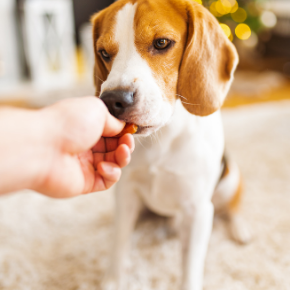
The Christmas holidays are a time when our pets tend to get a few more treats than normal. Nothing too wrong with that, assuming you stick to the 90/10 rule and treats end up comprising no more than 10% of a complete and balanced diet.
The good news is that, if you want to give them treats, there’s no need to spend a fortune on specially formulated food, when your fridge and your fruit bowl could be hiding a bunch of tasty titbits that your pooch will pounce on at the first opportunity.
Before you start on the treats though, why not take this opportunity to pop in for a free nurse led weight check at our Alexander Street surgery. A quick hop on the scales is never a bad thing and it may give you some good insight into how your dog’s diet should shape up over Christmas.
Book a Free Nurse Led Weight Check
Assuming all is well then you may like to know that many fruits and vegetables make wonderful treats for dogs. They are nutrient-rich, convenient and generally low in calories. Which will help you meet the challenge that many of us face in striking a balance between treating our furry friends and managing a healthy weight.
So, here are four of our kitchen essential favourites;
- Apples. Good for dogs and people! Packed with nutrients and fibre, a few pieces of apple are great snack, but don’t feed them the seeds or core.
- Green Peas. Defrosted green peas (or fresh) are great treats, and most dogs love them. Use as training treats or just put some in their bowl.
- Carrots. Loaded with vitamins, carrots are a kitchen staple you can cut into bite-sized pieces (depending on your dog’s size) and use as a healthy reward.
- Green Beans. Plain and simple when cut into manageable lengths, beans are a great source of fun & fibre.
Take it easy … peasy
There’s lots more, including bananas, broccoli and even cooked (and cooled) squash like pumpkin & sweet potato. Top tip… if you’re introducing new treats, then it’s generally best to start with one or two pieces to see how they get on.
Finally, it may seem obvious, but actually, dogs don’t really care what they are getting. Often, they crave the attention as much as the treat. So why not keep a fraction of their daily rations to hand out slowly as treats. Fun for you, rewarding for them, easy on their weight and kind to your pocket too.
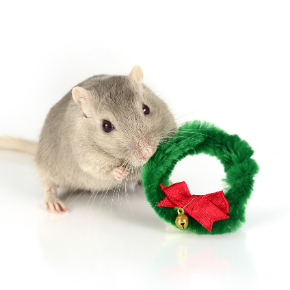
Adam Maxton, our head vet, has been thinking about hamsters, gerbils and other small mammals and how they might be impacted by Christmas in busy houses.
As with many of the holiday periods, houses can change, and routines can be disrupted. However, with a little forethought, you can ensure that your small furry friends have as good a time as the rest of the family.
Get our small mammal to-do list
Other pets
It’s a common time of year to get visitors. Whilst this year that’s less likely, if you do have visitors and they bring a dog, or if you get a new dog for Christmas, think about how you’ll keep your small mammal out of their way.
Stress & Small Furries
Leading on from that… stress caused by increased levels of noise, activity and the general hubbub of the festivities, can get cause small mammals great stress. Move your little friend’s cage to a quiet room for the holidays so they can remain calm.
Christmas Decorations
When you let them out of their cage for a run it’s best not to leave your small mammal unattended. Decorations, the wires of Christmas lights and piles of presents are just a few of the festive hazards we’re keen for them to avoid.
Food
Small mammals don’t do so well with food based treats so our advice is; if in doubt, leave it out! However most will appreciate a bit of apple or banana, or, rummage in your fridge and see if you have any peas, carrots or broccoli.
Buying them a friend for Christmas
You might be tempted to buy your pet a friend for Christmas. Nice idea (in fact essential) if they are a Gerbil or a Degu, but not such a great idea if they are a Syrian Hamster (who are solitary animals, who will fight if kept as a pair). Err of the safe side and give us a call before you buddy anyone up and we’ll tell you what’s good.
What you should do
If you have any problems over the holidays, then please do contact us and we’ll help you out. In the meantime, have a think about what we’ve said above and perhaps download our Small Furry Christmas Care To-Do List.




